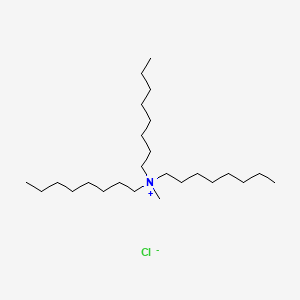D1020 | n-methyl-n,n-dioctyloctan-1-aminium chloride
| Toxicity | Dose | Time | Species | Model | Method | Action | Positive criterion | Reference |
|---|---|---|---|---|---|---|---|---|
| MEMBRANE POTENTIAL | 2.73±0.32 | human | qHTS-HepG2 | MMP assay | decrease | IC50 | 163 | |
| MEMBRANE POTENTIAL | 10 | human | HepG2 | MMP assay | decrease | IC50 | 163 | |
| MEMBRANE POTENTIAL | 19.58±4.89 | rat | hepatocytes | MMP assay | decrease | IC50 | 163 | |
| Pictogram | Signal | Statements | Precautionary Statement Codes |
|---|---|---|---|
    |
Danger |
Aggregated GHS information provided by 292 companies from 4 notifications to the ECHA C&L Inventory. Each notification may be associated with multiple companies. H301 (100%): Toxic if swallowed [Danger Acute toxicity, oral] H315 (98.97%): Causes skin irritation [Warning Skin corrosion/irritation] H318 (15.41%): Causes serious eye damage [Danger Serious eye damage/eye irritation] H319 (84.59%): Causes serious eye irritation [Warning Serious eye damage/eye irritation] H400 (15.41%): Very toxic to aquatic life [Warning Hazardous to the aquatic environment, acute hazard] H410 (15.41%): Very toxic to aquatic life with long lasting effects [Warning Hazardous to the aquatic environment, long-term hazard] Information may vary between notifications depending on impurities, additives, and other factors. The percentage value in parenthesis indicates the notified classification ratio from companies that provide hazard codes. Only hazard codes with percentage values above 10% are shown. |
P264, P270, P273, P280, P301+P310, P302+P352, P305+P351+P338, P310, P321, P330, P332+P313, P337+P313, P362, P391, P405, and P501; (The corresponding statement to each P-code can be found at the GHS Classification page.) |
     |
Danger |
Aggregated GHS information provided by 266 companies from 12 notifications to the ECHA C&L Inventory. Each notification may be associated with multiple companies. H301 (61.65%): Toxic if swallowed [Danger Acute toxicity, oral] H302 (38.35%): Harmful if swallowed [Warning Acute toxicity, oral] H314 (80.08%): Causes severe skin burns and eye damage [Danger Skin corrosion/irritation] H315 (19.92%): Causes skin irritation [Warning Skin corrosion/irritation] H318 (63.91%): Causes serious eye damage [Danger Serious eye damage/eye irritation] H361 (32.33%): Suspected of damaging fertility or the unborn child [Warning Reproductive toxicity] H400 (60.15%): Very toxic to aquatic life [Warning Hazardous to the aquatic environment, acute hazard] H410 (100%): Very toxic to aquatic life with long lasting effects [Warning Hazardous to the aquatic environment, long-term hazard] Information may vary between notifications depending on impurities, additives, and other factors. The percentage value in parenthesis indicates the notified classification ratio from companies that provide hazard codes. Only hazard codes with percentage values above 10% are shown. |
P201, P202, P260, P264, P270, P273, P280, P281, P301+P310, P301+P312, P301+P330+P331, P302+P352, P303+P361+P353, P304+P340, P305+P351+P338, P308+P313, P310, P321, P330, P332+P313, P362, P363, P391, P405, and P501; (The corresponding statement to each P-code can be found at the GHS Classification page.) |
| 07Q8S2MJ6A | 1-Octanaminium, N-methyl-N,N-dioctyl-, chloride | 1-Octanaminium, N-methyl-N,N-dioctyl-, chloride (1:1) |
| 1-Octanaminium,N-dioctyl-, chloride | 102055-EP2275469A1 | 102055-EP2289965A1 |
| 102055-EP2301983A1 | 5137-55-3 | 63393-96-4 |
| 74350-EP2298828A1 | 74350-EP2308857A1 | 93810-EP2305625A1 |
| A828561 | AB1001993 | ACMC-1BKYG |
| AK308459 | AKOS015902686 | AMMONIUM, METHYLTRIOCTYL-, CHLORIDE |
| ANW-31248 | Adogen 464 | Adogen(R) 464 |
| Adogen-464 | Aliquart 336 | Aliquat 336 |
| Aliquat(R) 336 | AliquatTM 336 | C-36719 |
| CAS-5137-55-3 | CHEBI:75286 | CHEMBL3188519 |
| CS-17393 | CS-W020733 | CTK3J1101 |
| Capriquat | DA-17487 | DB-050397 |
| DSSTox_CID_24487 | DSSTox_GSID_44487 | DSSTox_RID_80263 |
| DTXSID1044487 | EINECS 225-896-2 | F0001-1342 |
| FT-0621928 | FT-0635557 | KS-000001ZE |
| KSC491C0D | LS-18704 | MCULE-4914333032 |
| MFCD00011862 | Methyl trioctyl ammonium chloride | Methyltri-n-octylammonium Chloride |
| Methyltricaprylylammonium chloride | Methyltrioctylammonium chloride | Methyltrioctylammonium chloride, >=97.0% (AT) |
| N--methyl-N,N--dioctyl-1-octanaminium chloride | N-METHYL-N, CHLORIDE | N-Methyl-N,N-dioctyl-1-octanaminium chloride |
| N-Methyl-N,N-dioctyloctan-1-aminium chloride | N-methyl-N,N-dioctyl octanaminiumchloride | NCGC00255776-01 |
| NSC 61369 | NSC-61369 | NSC61369 |
| Q4726852 | RTR-018303 | SBB073021 |
| SC-26883 | SC-91616 | SCHEMBL108549 |
| ST45255433 | Starks catalyst | TOMAC |
| TR-018303 | TRA0068610 | Tox21_302198 |
| Tri-n-octylmethylammonium Chloride | Tricaprylmethylammonium chloride | Tricaprylyl methyl ammonium chloride |
| Tricaprylylmethylammonium chloride | Tricaprylylmethylammonium chloride, mixture of C8-C10 C8 is dominant; | Trioctyl methyl ammonium chloride |
| Trioctylmethylammonium chloride | Trioctylmonomethylammonium chloride | UNII-07Q8S2MJ6A |
| WLN: 8K8&8&1 &G | XKBGEWXEAPTVCK-UHFFFAOYSA-M | aliquat-336 |
| methyl -trioctyl-ammonium chloride | methyl trioctylammonium chloride | methyl(trioctyl)ammonium chloride |
| methyl(trioctyl)azanium chloride | methyl-tri-octylammonium chloride | methyl-trioctyl-azanium |
| methyl-trioctylammonium chloride | methyltrioctylamine, chloride | methyltrioctylammoniumchloride |
| tricapryl-methylammonium chloride | trioctyl methylammonium chloride | trioctylmethyl ammonium chloride |
| trioctylmethylammoniumchloride |
| CAS Number | 5137-55-3, 63393-96-4 |
| PubChem Compound | 21218 |

